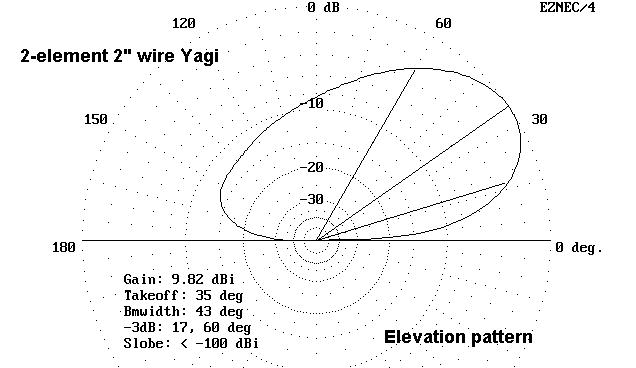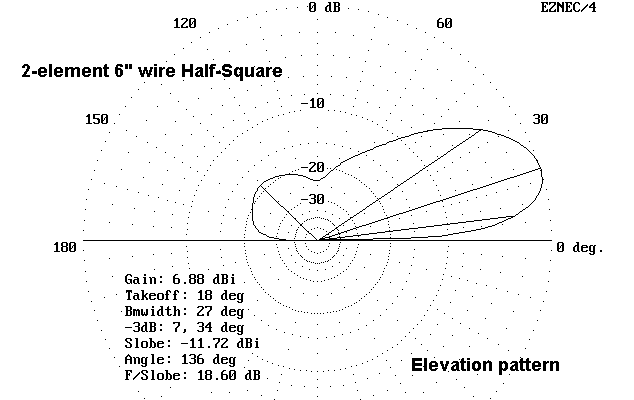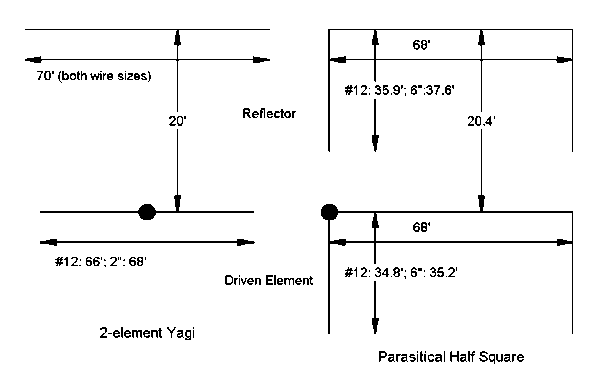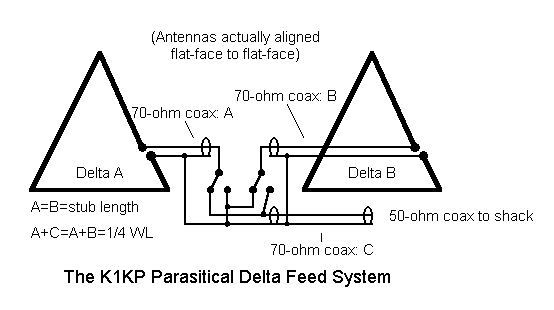Some Notes on Lower HF Wire Beams
Fixed position wire beams still have a place in amateur communications from 40 through 160 meters. However, I am not certain we always make the right and patient choices in selecting and building wire beams. We tend to treat them as field Day temporary antennas rather than really building them to do a job.
The Wire Yagi
Consider the 2-element wire 40 meter beam. It is an improvement over the dipole in several ways. 1. It provides forward gain; 2. It provides rear attenuation; and 3. It lowers the elevation angle of maximum radiation by a few degrees. Most of these advantages are captured in the elevation plot below: Gain = 9.5 dBi; Front-to-back ratio = 14 dB; TO angle = 35 degrees; Feedpoint Z = about 50 ohms, all at a height of 50′ over average ground, centered at 7.15 MHz.

For reasons that appear below, let me give the performance figures for an elevation angle of 18°, near the lower -3 dB point. Gain = 7.5 dB; F-B = 12.7 dB.
Here are the dimensions that will yield this performance. Driven element = 66′; reflector = 70′; spacing = 20′ with #12 or #14 copper wire. However, the 2:1 SWR bandwidth od the antenna covers only about 2/3rds of the 40 meter band. Moreover, especially on the low end of the band, the pattern goes to pot.
Let’s redesign the antenna by making one simple change: increase the wire size to 2″ in diameter. The dimensions for this fat wire Yagi are these: Driven element = 64′; reflector = 70′; spacing = 20′. Now the 2:1 SWR bandwidth of the beam exceeds the limits of 40 meters, as the following table demonstrates:
| Frequency MHz | Gain dBi | Front to Back dB | Feedpoint Impedance R +/- jX ohms | SWR |
|---|---|---|---|---|
| 7.0 | 7.9 | 11.1 | 36.4 – 13.4 | 1.6:1 |
| 7.1 | 7.6 | 12.5 | 45.3 + 3.3 | 1.1:1 |
| 7.2 | 7.4 | 12.6 | 54.0 + 18.3 | 1.4:1 |
| 7.3 | 7.3 | 11.9 | 62.2 + 32.0 | 1.8:1 |
Of course, 2″ wire is impractical, and 2″ diameter tubing is too heavy for any installation. So the antenna is impractical–unless we remember that we can simulate fat wire with an array of thin wires spaced apart. The simplest scheme to achieve most of the benefits is to use two wires making a flat wire about twice the diameter of the wire used in the model. This 2:1 rule of thumb is not precise, but adequate for most simple design cases. Take two wires and a bunch of spacers (1/2″ thin wall CPVC is an adequate substitute for varnished or parafinned wooden dowels) and make lengths of flat 4″ wide wire. Not only connect the ends, but as well solder shorts across the wire periodically. Now we have the material for a wide-band 40-meter beam.
The Parasitical Half-Square
The wire Yagi is the ultimate in simplicity for a directional antenna, but it may not be the best. We often forget that we can add parasitical elements to almost any wire antenna. Parasitical extended double Zepps were known back in 1938. More practically, a half square will fit the half wavelength horizontal space of our Yagi, with vertical dangling from the 50′ high point to about 12 to 14 feet or so above ground. Can we add a reflector about 20′ or so behind a half square and change the bidirectional pattern to a monodirectional one? Yes, as the plot below demonstrates. The operating performance of a #12 wire parasitical half square is given by these numbers: Gain = 6.6 dBi; F-B = 23 dB; TO-angle = 18 degrees; Feedpoint impedance = 56.9 + 3.4 ohms. The reason for giving the 18-degree performance figures of the Yagi is now apparent.
The dimensions of this wire parasitical half-square are these: Horizontal length of both elements = 68′; driven element vertical length = 34.8′; reflector vertical length = 35.9′; spacing = 20.4′.
The advantage of the half-square is that at elevation angles below 18 degrees, its gain drops off much more slowly than does the Yagi gain. In addition, it lacks significant gain above 35 degrees, reducing incoming high angle QRM and QRN. These are, of course, advantages to the DX operator; the Field Day and Sweepstakes operator may prefer the Yagi precisely because of its higher angle radiation pattern.
One distinct disadvantage of the wire parasitical half-square is narrow bandwidth–about 100 kHz on 40 meters. To increase the bandwidth both in terms of 2:1 SWR and pattern retention, we must increase the wire size to about 6″ in diameter. Then we obtain these dimensions: horizontal length of both elements = 68′; driven element vertical length = 35.2′; reflector vertical length = 37.6′; spacing = 20.4′. Some may find it odd that we increase the element lengths as we fatten the wire of the half-square. However, remember that the half square belongs to the family of 1 wl loop antennas, and like a quad, lengths grows with wire diameter.
With these dimensions, we can achieve the elevation plot below.

Here is a chart of performance checkpoints through the 40-meter band:
| Frequency MHz | Gain dBi | Front to Back dB | Feedpoint Impedance R +/- jX ohms | SWR |
|---|---|---|---|---|
| 7.0 | 6.9 | 10.1 | 37.5 – 21.8 | 1.8:1 |
| 7.1 | 6.9 | 21.2 | 60.5 + 4.6 | 1.2:1 |
| 7.2 | 6.5 | 18.6 | 79.3 + 15.1 | 1.7:1 |
| 7.3 | 6.1 | 10.0 | 85.9 + 23.1 | 1.9:1 |
The design center of the fat-wire half square was 7.07 MHz. Selecting this lower frequency was necessary to preserve a directional pattern across the band with a reasonable SWR figure at both band edges.
Like the fat-wire Yagi, the fat-wire parasitical half-square requires construction of the antenna wires using the same principles, but this time with a spacing of about 12″.
The figure below compares the shapes of the two antennas and summarizes both #12 and fat-wire dimensions.

The Parasitical Right-Angle Delta
As with the half-square, it is also possible with delta loops to derive well above 3 dB forward gain (relative to a single loop) and a front-to-back ratio of 10-15 dB by placing two vertical loops about 0.15 wl apart. The result is a parasitical 2-element beam with the same low TO angle. The beamwidth will be fairly wide: 80-90 degrees, without the side nulls we are used to with upper HF high altitude Yagis. Feedpoint impedance will be to the 60-65 ohms range at resonance.
Expect both the driven loop and the the reflector to be a bit shorter than a resonated single loop, with the driven element shorter than the reflector.
If you care to scale some numbers from 7.15 MHz, here is a right angle delta loop and its 2-element counterpart. Given are the baseline and height (one is twice the other), and the sides are about 1.414 the height. This model had a maximum height of 60.4′ which was held constant for the 2-element version to achieve comparable TO angles (17 degrees for the model)
| Antenna | Baseline | Height | Spacing |
|---|---|---|---|
| Single RA Delta | 60.8′ | 30.4′ | |
| 2 Element RA Delta | |||
| Driven Element | 59.3′ | 29.65′ | |
| Reflector | 60.6′ | 30.3′ | 20.5′ |
When made into a parasitical beam, the deltas also show reduced 2:1 SWR bandwidth (relative to their resonant impedance). At 40 meters, both SWR and pattern begin disintegrating somewhere around +/- 50 kHz from the design point with #12 wire. Widening that bandwidth depends upon using truly fat wires with equivalent diameters of about 6″ at 40 meters for full band coverage with reasonable gain and F-B (arbitrarily defined here as 3 dB gain over a single loop, greater than 10 dB F-B, and less than 2:1 SWR).
K1KP uses a simplified version of the ON4UN feed for his 80 meter delta loops, which have their apices up at 70 feet and base legs about 8 feet off the ground. The apices are spaced 20 feet apart, with the bases spread to a distance of about 50 feet. He reports that the feedpoint impedance is close to 100 ohms. Each feedpoint runs to a central switch, roughly as sketched in the drawing. (Not shown in the drawing are baluns at each loop feedpoint to isolate each antenna. Also not shown is the tilt of each loop toward the other.)

Coax sections A and B to the switches are lengths of RG-11/U foam (with a higher velocity factor than non-foam coax) coax, 36 feet long. The switch is a relay that selects one feed as the driven element. 16 more feet of RG-11/U foam coax adds to the 36 feet on the driven element to form a quarter wave matching section, yielding a 50-ohm impedance for the coax to the shack.
The relay also shorts out the end of the other line forming the reflector. The shorted 36 foot coax line functions as a loading inductance to lengthen the electrical size of the loop in use as a reflector.
K1KP reports reasonable flat SWR and detectable gain over the single loop with this system, which is fairly close-spaced (average distance = about 1/8 wl) as parasitical systems go. It represents an ingenious way to switch beam directions and simplify feedline requirements without sacrificing performance from the wire array.
Incidentally, models of the half square and the single loop DMS (otherwise known as a side-fed rectangle) show about a dB gain advantage over the delta loops, and this gain also transfers to parasitical arrays of them.
A 2-element wire Yagi will give slightly more gain at 17 degrees elevation when mounted at the apex height of the delta. However, its elevation angle of maximum radiation is about double that of the SLV group, and the SLVs have higher gain below the 17 degree mark, with 1/2 power points ranging from 7-10 degrees elevation, depending on the actual antenna height. Hence, the choice of antenna types depends on the user’s operating goals.
The 70′ by 21′ rectangular area necessary for these antennas is about the same. If the concept of a fixed position wire beam is useful, then the decision as to which antenna to build may rest on which performance characteristics one prefers relative to one’s operating goals. However, whichever you build, it is wise to take the added pains of fattening the wires to give good performance across the band.
Originally posted on the AntennaX Online Magazine by L.B. Cebik, W4RNL
Last Updated : 14th March 2024
